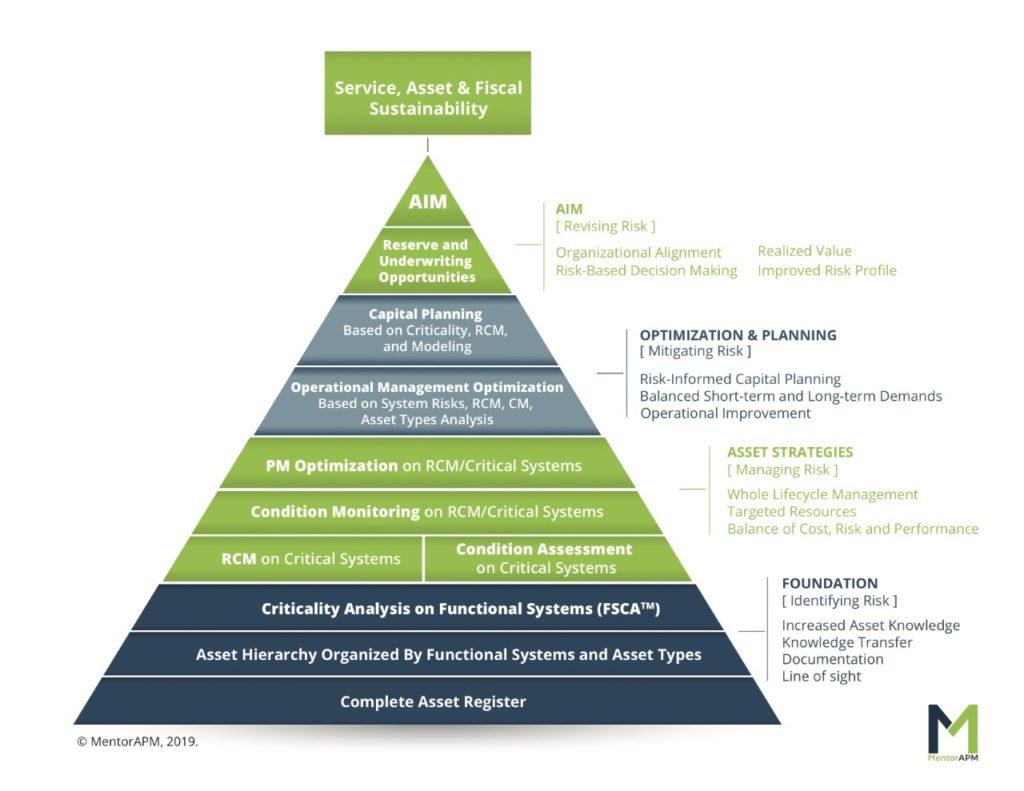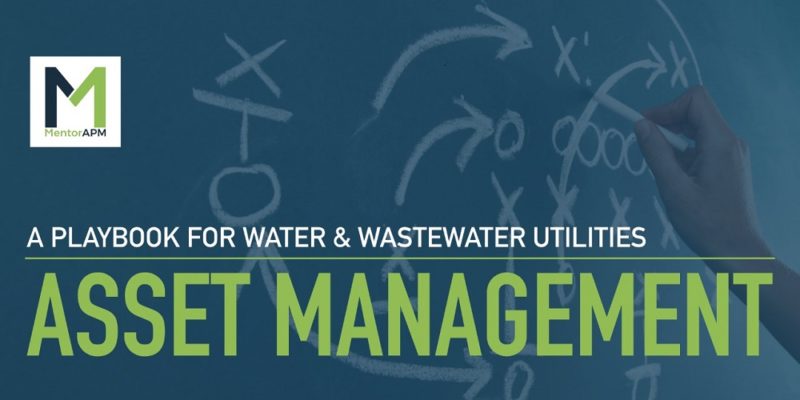Coverage of asset management stories are support by MentorAPM

Water and wastewater utilities across the country are under enormous pressure today. In 2017, the Infrastructure Report Card assigned our nation’s wastewater systems a grade of D+, reflecting decades of insufficient investment to keep up with growth and expansion. It is expected that demand on current systems will grow by more than 23% by 2032. The need is huge for upgrading existing aging systems and bringing new ones online.
In addition to bearing the burden of past short-term thinking and chronic under-investment, utilities are scrambling to respond to the rapidly changing risk landscape posed by dramatic climate events and new vulnerabilities to hostile actors.
None of this is news to utility operators on the frontline. Water and wastewater utilities are vanguards for the protection of public health in our communities and they are constantly working to keep systems running and resilient in spite of inadequate resources. There is always more that can be done to manage our wastewater assets efficiently and effectively, but rarely is there enough money or time to do it all. And now, with new emerging smart technologies, even more complex decisions have to be made about how to best allocate limited resources.
Across the country, utilities that are adopting asset management programs are discovering a framework for better decision-making that is transforming their overall utility operation – criticality-driven Asset Performance Management. Because transforming utility performance requires changing how we manage the performance of the assets inside our utilities.
Asset management is the coordinated activity of an organization to realize value from their assets. More simply put, asset management is doing the right things, in the right order, for the right reasons, to get the right results.
A successful asset management program connects your overall mission and strategic outlook to the daily execution of asset care. You start with understanding why you exist, what you do, how you are expected to do it and who is doing it. This establishes line of sight from the top of your agency to your field crews, and builds consensus on priorities.
Asset Performance Management (APM) is part of the bigger asset management framework and involves collecting and interpreting information about your assets so you can make better decisions about your asset strategies, to maintain performance while managing costs and avoiding risks. APM activities include applying principles and practices of reliability like Reliability Centered Maintenance (RCM), FMECA, root cause analysis, defect elimination, asset condition assessment and monitoring, and failure mode management.
A criticality-driven APM program starts with criticality assessments to first identify critical assets and develop risk profiles for the operation, in order to target asset strategies in the right place and deliver the best ROI for maximum impact on utility performance improvement. Too often, utilities are running expensive initiatives like asset condition assessment programs or major capital improvements without first assessing risk and criticality.
Utilities that have adopted a criticality-driven APM framework are seeing real results and positive impact on their overall service delivery and financial sustainability. Here are a few examples.
The Sanitation Districts of Los Angeles County serves 5.6 million people and is the nation’s largest producer of recycled water. The agency operates and maintains 11 wastewater treatment plants, 49 pumping plants and 1,400 miles of sewers.
As part of a larger asset management plan, LACSD completed pilot criticality assessments for two of their facilities, coached by the MentorAPM team and using Criticality Analyzer™, a module in the MentorAPM suite. These assessments identified and ranked critical assets and established facility risk profiles. In addition to immediate risk mitigation activities, inspection schedules for pipes were reprioritized to accurately assess risk for critical assets. The results are also being used to direct RCM studies, PM optimization and capital budget review for high critical assets. Using this framework, LACSD has a clear path forward for rolling out their asset management plans across all of their facilities.
Another agency in Southern California had been planning for the substantial redesign and expansion of its sole water reclamation facility. Then the plant expansion was put on hold for legal reasons and declining flows. The agency was forced to reduce its repair and maintenance budget by deferring repairs and capital improvements pending the plant expansion. Seven years later, with the expansion still on hold, the accumulated deferred maintenance and capital improvements required drastic decision making for resource allocation. The agency undertook a criticality analysis as part of adopting an asset management framework.
During the discovery phase of the analysis many risk-mitigating opportunities were identified. Many required little more than a modification of certain staff duties and administrative functions. Some required a slight modification of operational management, and very modest capital commitment, often out of the maintenance budget or within the manager’s signing authority.
Some, however, did indicate possibly substantial capital commitment to mitigate significant operational risk. An agreed follow-up priority list was created that influenced both maintenance and engineering activities after the analysis. The criticality-driven approach charted a path out of the deep hole of deferred maintenance and capital improvements, toward service, asset and fiscal sustainability.
One of the most important outcomes of a criticality analysis is risk discovery and mitigation. During an assessment, there is always unknown risk uncovered. Often the risks are relatively small, but sometimes it is very significant and major disasters are averted.
In a privately operated treatment facility serving one of the major refinery operations in Los Angeles County, the management team undertook a criticality analysis in support of capital project for a boiler feed water pretreatment system expansion. The facility had undergone several design review and HAZOP studies and it was assumed that the systems were well understood. The assessment was expected to confirm known risks.
Previous thinking had placed the highest risk on the actual softener units that had internal corrosion issues, valued at almost $1MM, which would impair capacity. However, the analysis showed that the failure of a $10K brine recharge system would bring the whole treatment facility to a full shutdown in less than a shift with no alternative or backup. This event would have a serious impact to the refinery operational cost, even possible reduction of boiler capacity, in addition to triggering contractual damages as a service provider to the refinery. The lead-time to replace the system was four weeks and any unexpected downtime of the brine system would have been clearly unacceptable. The potential cost of the risk was hundreds of times that of the brine pump system cost.
As a consequence the pump system was evaluated for condition and severity of service load. The decision was made quickly to replace the pump with a new and more robust one.
In addition to charting a path forward and uncovering risk, a criticality-driven APM program will target resources and reduce waste, redirecting time and money towards critical assets and away from unimportant activities.
Metropolitan Council Environmental Services (MCES) oversees wastewater treatment, water supply and water quality for the Minneapolis-St. Paul region and is facing increased capital investment pressure due to aging assets, rising debt service costs, knowledge loss due to staff retirements, and increasing regulatory requirements.
To support the current wastewater treatment system, valued at over $6 billion, MCES contracted for two criticality analyses to identify system/asset structure and provide a criticality ranking for equipment in two facilities.
The first phase addressed the main plant fluidized bed solids incineration facility. More than 4000 assets were assessed in less than six weeks. Phase two covered the main treatment plant (250 mgd design capacity) and was completed under budget and ahead of schedule again. This time over 4500 assets were assessed in less than six weeks.
In each assessment, at least 50% of assets ended up with revised criticality rankings, including discovering high critical assets that were previously identified as low critical and vice versa.
This adjustment of criticality rankings identified work orders, money and effort that were not being spent on the right assets and the opportunity to reallocate millions of dollars in annual maintenance budget to more critical assets. It is estimated that the total resource reallocation is around $5 million.
The analysis also identified priorities and validated capital requirements for targeted infrastructure investment.
Historically, water and wastewater utilities that have implemented a criticality analysis in support of an APM program, have realized at least a 5% reduction in both their capital and maintenance budgets within the first 12 months.
MCES estimates that their initiative will realize significantly higher savings in their capital and M&R budgets. Preliminary analysis suggests that 20% of the maintenance budget will be saved alone through reduction of emergency costs on low-critical assets.
For large agencies, the reduction of emergency work, the prioritization and optimization of preventive maintenance, and the targeting of maintenance and capital budgets toward high critical systems will translate into millions of dollars saved.
Any agency of any size can benefit from adopting a criticality-driven Asset Performance Management framework and achieve similar outcomes. Here are a few key things to keep in mind.
 Adopting a criticality-driven Asset Performance Management framework is driving transformation in utilities today to overcome the challenges of chronic under-investment and the rapidly changing risk landscape and assure the delivery of essential services.
Adopting a criticality-driven Asset Performance Management framework is driving transformation in utilities today to overcome the challenges of chronic under-investment and the rapidly changing risk landscape and assure the delivery of essential services.
Learn more at www.mentorapm.com and download your free playbook for utility asset management here: https://mailchi.mp/6a5c7c5bf73f/asset-management-playbook-for-utilities